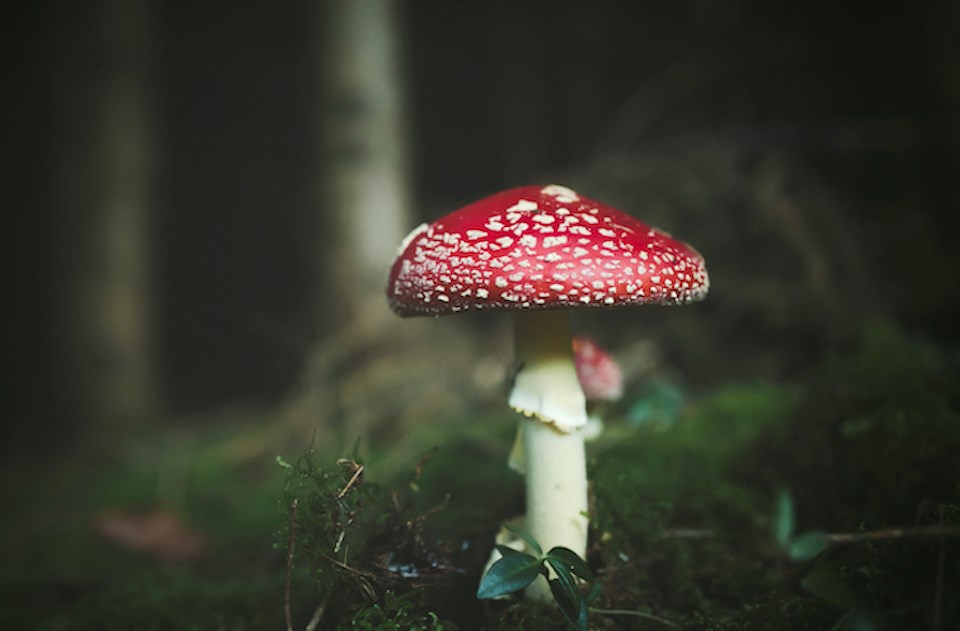Roadside Metro Vancouver mushrooms may look magically delicious, but you might bite off more than you can safely chew.
If cuteness were an ideal way to gauge the safety of fungi, locals could have their pick between brightly coloured toadstools adorned with white spots and frilly undersides.
But alas, these vibrant hues and pleasing shapes aren't necessarily indicative of how much they could hurt you.
Vancouverite David McLeish wrote in a Facebook post that he was walking by Granville Loop Park when he spotted some bright-coloured fungi in the grasses between the playground, tennis courts, and dog park.
"I don’t know anything about mushrooms, but someone who seemed to know said these red cap mushrooms are poisonous," he remarked, advising people to "watch out."
Red-capped 'Mario' mushrooms are poisonous but not 'deadly'
The good Samaritan imparted some wisdom to McLeish, according to University of British Columbia Researcher (UBC) Professor of Botany Mary Berbee, but the tiny fungi aren't fatal.
"Those lovely fly agarics -- red-capped 'Mario' mushrooms along city streets -- probably arrived in Vancouver by accident," she told V.I.A. "They aren't native here (although some of their very close relatives are native). They may have arrived attached to the roots and soil of our street trees, [and then] spread by spores.
While the red-capped mushrooms have been here for decades, they become predominant in mid to late October, explains Berbee, who adds that "they are poisonous, but not deadly."
Berbee, who gives talks at local mushroom clubs and leads fungi forays on UBC Campus and in B.C. parks, says foraging folks need to ensure they can identify certain species before they plan on chowing down.
In particular, the death cap, Amanita phalloides, poses an immediate risk to humans (if the name didn't already give that away). Unfortunately, and unlike the aforementioned species, these fungi don't have a bright colour that screams, "I am poisonous." Instead, this one looks similar to those that are safe to eat, making them a problematic pick. Eating them may lead to liver and kidney damage as well as death.
"Get to know the death cap, so that you can be absolutely sure to avoid tasting this one," Berbee underscores.
How will I know if I have come across a death cap mushroom?
A death cap looks like the Asian straw mushroom (Volvariella volvacea) and other common Asian varieties of edible Amanita species.
"The symptoms of death cap mushroom poisoning include low blood pressure, nausea and vomiting (which begins 8 to 12 hours after ingestion). After up to 24 hours have passed, the symptoms seem to disappear and you might feel fine for up to 72 hours. Symptoms of liver and kidney damage start three to six days after the mushrooms were eaten," according to the BC Centre for Disease Control (BCCDC).
Half of adults who consume two death caps will die, Berbee notes, adding that death takes about seven to 10 days.
If you suspect you've ingested a death cap, seek immediate emergency health care; early treatment is crucial. Call the BCCDC Drug and Poison Information Centre 24-Hour Line:1-800-567-8911 or 604-682-5050 on your way to the closest hospital emergency room. Bring a specimen of the mushrooms with you and information about where you discovered it to speed up your recovery.
Are any local mushrooms safe to eat?
While there are some dangerous fungi, some urban mushrooms are edible for most people, including the shaggy mane -- a cylindrical, pearl-coloured species that eventually oozes black, which is when you must not consume it -- and the oyster mushroom, which a white to grey-brown species that is identified as "fan- or shell-shaped with a stem that is off-centre, at the side of the cap," according to the UBC Beaty Biodiversity Museum.
Keep in mind, however, that "cap colour does not indicate toxicity" and the "death cap has a pale cap, ranging from light yellowish to brownish," Berbee notes.
Before you consume any of your harvests, check their identity at a regional mushroom club or association. UBC's online guide can point you in the right direction but it also contains edible species that are easily confused with poisonous ones.
Pets may also eat mushrooms that make them sick or can kill them. If your pet has been eating wild mushrooms, take them to the vet and bring a sample of the mushrooms they ate, if possible.
"Put the samples in a yogurt container with a dry paper towel and a lid, refrigerate, and the mushrooms will still be useful for identification for several days," Berbee advises.
How the Vancouver weather forecast affects wild mushroom growth
Mushrooms grow year-round but tend to come out more during the spring and fall. This means that October is an optimal time to harvest them but it is also the time when pets or children might accidentally eat them.
Right in time for spooky season, red-capped fly agarics peak in October. Most fungi thrive in moist places, which is why you'll often see a collection deep on a moss-covered forest floor, or taking up residence on a fallen log.
To stay up-to-date on potential foraging conditions, check out hyperlocal forecasts for neighbourhoods across the Lower Mainland on Weatherhood. You can find out if rainfall is on the cards for up to seven days, as well as other important information like temperature, wind pressure, and more.



